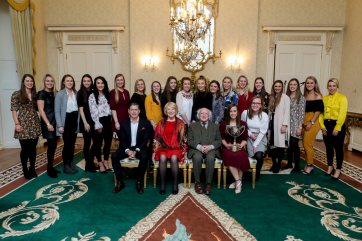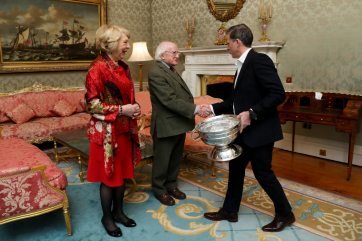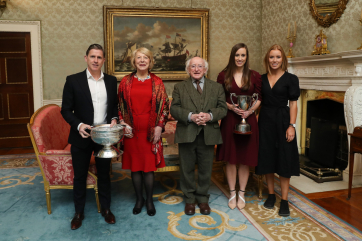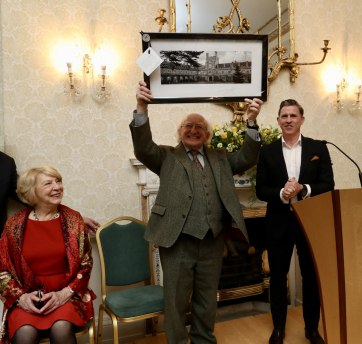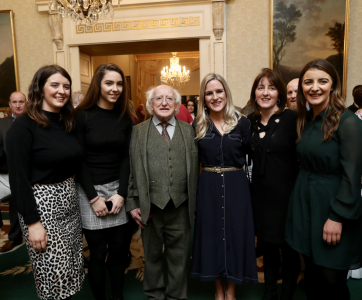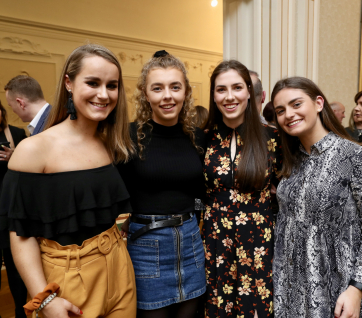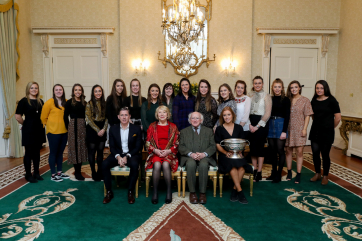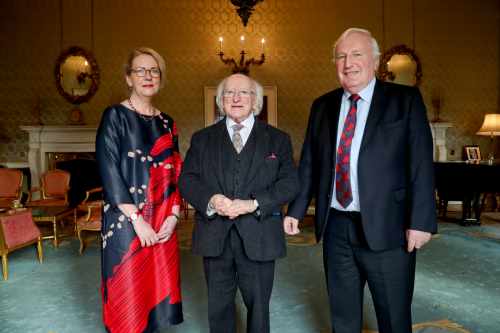Speech at the National Biodiversity Conference
Dublin Castle, Thursday 21 February 2019
A chairde,
In so far as language is part of biodiversity, let me begin with just some words in our own ancient language.
Ar an gcéad dul síos ba mhaith liom mo bhuíochas a ghabháil libh uilig as ucht an cuireadh a bheith libh inniu agus as ucht an fíorchaoin fáilte a dhearadh sibh romham ar maidin. Is í seo an dara lá agus sinn bailithe le chéile chun an t-ábhar rí-thábhachtach seo á phlé- bithéagsúlacht - agus an dúshlán atá romhainn ar fad chun í a chaomhnú.
Good morning everyone. I was delighted to receive an invitation to address you today and I am equally delighted to stand before what looks like a very diverse group of delegates: young people, community groups, farmers and businesses, together with specialists from every facet of the conservation sector.
I am particularly pleased to see that the Director General of the International Union for the Conservation of Nature Inger Andersen is present here, as is Humberto Delgado Rosa from the European Commission. I had the pleasure of speaking with Inger Andersen at Áras an Uachtaráin yesterday evening and I would like to publicly join with all of you here in wishing her well in her new position with UNEP.
The protection of Ireland’s, and indeed the world’s, biological diversity is a topic with which I have been involved for several decades. It was an interest in that issue that brought me to the Earth Summit in Rio 27 years ago.
1992 represented such a hopeful juncture when it seemed that the world was finally coming together to address the existential challenges of our age. The summit gave impetus to the three sister United Nations Conventions, on Climate Change, Desertification and Biological Diversity. So many of you in this room today have spent your careers engaged directly or indirectly in pursuing the objectives of those conventions and while there have been some notable advances to this end, I think it is fair to say that the agenda of work recognised then is far from complete.
I would like to begin today by thanking Minister Josepha Madigan, her officials in the Department of Culture, Heritage and the Gaeltacht and the Irish Forum on Natural Capital, for hosting this important event.
It is truly encouraging to see that the Department, through its National Parks and Wildlife Service has taken this initiative to help put biodiversity protection centre stage not only in the public’s consciousness but, as importantly, in the consciousness of policy makers and officials who deal with a broad range of sectors that have direct impacts on the health of Ireland’s biodiversity.
I would also like to welcome the announcement made by Minister Madigan yesterday in regard to the increased resources being made available to protect biodiversity. This is an important move in the right direction.
Some of you may remember that I once had ministerial responsibility for Nature protection. Since then I have been lauded and condemned, in not quite equal measure, for the actions I took in that role. While I was not the negotiator of the source directive, I had responsibility for introducing the regulations that first transposed the Habitats Directive into Irish law and for initiating the process of designating the first of the Special Areas of Conservation under that Directive. Over my years in Government, before and since then, I have gained, I think, some understanding of the challenges that are faced in persuading the political and administrative systems, organised interest groups and indeed the general public, of the necessity to think long and inter-generationally and act, in all of our interests, to protect our shared environmental, ecological and climatic assets, assets that are not infinite.
Non-State actors have been, I believe, to the forefront in raising our awareness of the issues involved and of the continuing and emerging threats to our environment. The Irish Environmental Network, with the weight of its 32-member organisations comprising 35,000 members, has been a welcome voice in our public discourse on biodiversity loss and has worked constructively with Government where circumstances allowed. But it also has served and continues to serve a crucial function by challenging public policy and public authorities when they fall short of what is needed to protect our wildlife.
As President of Ireland, I have been inspired by the work of communities that are indeed far-seeing, for example, those who have taken it upon themselves to restore wetlands and raised bogs, the volunteers working with Birdwatch Ireland to monitor changes in bird populations and by An Taisce with its consistent and well informed advocacy for nature. It is crucial to our democracy that groups can and do act where they perceive a threat to the common good.
I am also deeply encouraged by the quality of academic and research work being undertaken in our colleges, institutes and universities about which you will have heard much yesterday and will hear more later today. The importance of scientifically grounded and evidence-based policy making is key if we are to successfully meet the challenges that confront us.
For those challenges are profound.
Around the world, the library of life that has evolved over billions of years – our biodiversity – is being destroyed, poisoned, polluted, invaded, fragmented, plundered, drained and burned at a rate not seen in human history.
I first stood for election to Dáil Éireann in 1969. In the fifty years since that time the world has witnessed relentless reductions in wildlife populations, in the size and health of the ecosystems they live in, and in the genetic diversity of the species themselves.
What is now rightly referred to as the ‘extinction crisis’ is due to us. Only a quarter of the world’s terrestrial surface remains untouched by human hand and even those places are not escaping the impacts of climate change. It is estimated that human activity has multiplied the normal rate of extinction at least one hundred-fold.
Over the past half century, humanity has witnessed the destruction of 60% of mammal, bird, fish and reptile populations around the world.
The examples of how Ireland’s biodiversity is suffering are also many and vivid:
Our raised and blanket bogs have been systematically degraded through peat extraction, drainage and inappropriate tree planting.
The European Eel, which once arrived from the Sargasso Sea to Irish rivers in numbers vast enough to support an industry, is now critically endangered. The beautiful Pearl-bordered Fritillary butterfly, one of the symbols of the Burren, is now endangered.
Some of our species-rich grassland habitats have declined by up to 30% in the last decade alone.
The Corncrake and Curlew which were integral sounds of the Irish countryside have been pushed to the edge of extinction as breeding species. The Hen Harrier is suffering habitat loss in its upland terrain, under pressure from forestry and windfarm development. The Freshwater Pearl Mussel, once a widespread inhabitant of our pristine rivers and a tell-tale species of water quality is now in serious decline in all bar a handful of sites.
Those vital refuges and corridors for Ireland’s wildlife, its hedgerows, are under increasing pressure.
Our own Government reports that 91% of internationally important habitats in Ireland have ‘bad’ or ‘inadequate’ conservation status. Studies over the past five years have shown that of 202 species of commonly occurring birds in Ireland, an alarming 63% are now on the Red and Amber Lists of Birds of Conservation Concern.
30% of Ireland’s wild bee species are threatened with extinction and studies suggest that we in Ireland are losing butterflies and bees at a faster rate than in the rest of the world.
If we were coal miners, we would be up to our knees in dead canaries.
We are the first generation to truly comprehend the reality of what we’re doing to the natural world, and we may the last with the chance to avert much of the damage. With this knowledge comes an extraordinary burden of responsibility that we all share.
As I look around me today, I am heartened to see the faces of the people who have accepted that responsibility with open arms, passion and commitment. I am struck by their sense of determination in the face of decades of difficulties. Too often, like Cassandra heralding the fall of Troy, they have struggled to be listened to and their warnings have gone unheeded.
They were often viewed as an inconvenient voice, a crank or an obstacle to what some call progress. NGO’s, individual citizens and concerned voices within the public service have too frequently been greeted with a dismissive distain when they pointed to the environmental consequences of a proposed course of action.
Today, these previously dismissed or excluded voices are the voices that must be listened to. The testimony of the informed, of the expert adducing empirical evidence, of those not simply representing a particular political or sectoral interest will be increasingly vital in bringing our decision-making processes to the simple understanding that what damages nature’s interests damages the interests of all, including future generations. We cannot achieve sustainable development if we do not change our mindset, change our approach and achieve a symmetry between ecology, economics and ethics.
Politicians and public servants must equip themselves with the necessary expertise to adequately represent our citizens’ interests in this regard. If we are to reverse the astonishing degradation we have witnessed in our habitats and species, nature conservation must become a central preoccupation within agriculture, land-use planning, forestry, energy, flood relief management, transport and fisheries policy and practice, to name but a few.
We can only succeed when those who oversee these sectors, and those who are engaged within them understand the threat, accept the need to change our approach and act in our collective interest.
There are many, many people across Ireland who are already working for nature.
I am referring to communities and individuals who give up their time to help wildlife, whether it’s cleaning a beach or restoring a bog or through the appropriate planting of trees; the organic farmers and the nature-friendly gardeners, the Tidy Towns committees, who have embraced biodiversity projects to add to the list of contributions that these commendable citizens make to their communities.
I also refer to the 7,000 citizens who have submitted hundreds of thousands of records to the National Biodiversity Data Centre, who not only collate these and many other biodiversity records, but in doing so strengthen the linkages between conservation scientists, civil society and government agencies.
The success of the innovative farmer-led programmes such as Burren LIFE and Aran LIFE must also be recognised; where the important role of farmers as custodians of the land was acknowledged and respected, and where the European Union and Government Departments have shown that they can work together in the interests of conservation.
While this is welcome, participants in these programmes sadly make up only a tiny minority of our farmers. I do wonder, however, whether we are making best use of the significant level of public money that is being spent on environmental measures in the agricultural sector and whether we are doing enough to harness the goodwill of farmers towards biodiversity protection.
Assessment of the environmental benefits of EU farming subsidies has been historically weak. Farmers and foresters must be clearly encouraged away from what we know are damaging practices and encouraged towards farming in harmony with nature. In this regard, there is surely a critical role for the European Commission and for our own authorities in creating the context in which Irish farmers can move quickly towards truly sustainable agriculture.
The All-Ireland Pollinator Plan is another example of exceptional public engagement and its success in raising awareness and stimulating action for the plight of our pollinators is un-paralleled: I am hoping that Áras an Uachtaráin can also become more involved in this initiative soon.
We must also remember the wealth of biodiversity in our marine waters. Recent surveys by the Marine Institute and the National Parks and Wildlife Service have mapped habitats as deep as 3000m, revealing escarpments, sea mounds and cold-water coral reefs. Meanwhile, the enormous undertaking of the Observe programme has seen the mapping of whales, dolphins and sea-birds across hundreds of thousands of kilometres of our seas.
We have never known as much as we do today about the world around us. Like many others I have been impressed by the cinematography and passionate presentation of recent nature documentaries such as ‘Wild Ireland: The Edge of the World’; ‘Eco Eye’, ‘Living the Wildlife’ and ‘Wild Cities’, among others. These are vital in bringing the wonders of our wildlife into view but also in alerting us to the dangers that it faces. They are reminding us of what we are losing as a consequence of existing practices that fallaciously see such resources as inexhaustible.
Our natural world, and the crisis it is currently undergoing, demands more of this type of coverage to help the public appreciate the urgency of action to prevent its destruction. I am encouraged that these issues are being picked up within mainstream journalism. For example, in the Sunday Business Post last weekend, Tom McGurk had very interesting, and stark, article entitled “insect apocalypse is a wake-up call for us all”.
Most of us probably developed our fascination with nature in early childhood. For some of us that wonder diminishes as we grow up and become distracted by life’s pre-occupations, but for many it remains dormant, ready to be awakened. The enduring popularity of nature programmes is a testament to this curiosity and wonder that can be used to rekindle people’s innate fascination for and interest in nature, and hopefully it may engender a general awareness of the importance of protecting nature.
The roots of our national connection with the natural world reach down to the very dawn of civilisation. These roots wind their way through our foundation myths and legends, and rise again, flowering in our culture where they offer creative sustenance to our poets, musicians, writers and artists: We need only think of An Bradán Feasa, the Salmon of Knowledge, the Children of Lir, Toraíocht Dhiarmada agus Gráinne for evidence of a time where we seem to have been more comfortably in tune with the world around us.
In this 21st Century, more and more people are living in urban centres that can seem far removed from the natural world, and in rural Ireland, how many of us take time out of our cars and our modern lives to notice the changes that are happening all around?
In many ways it is part of the hubris of that which we have titled modern civilisation, modern consumption and life as we have allowed it to develop. We have come to see ourselves as somehow separate from nature, or in competition with it, or even the assumption that we inhabit a distinct ecosystem that is immune from the damage that we are causing around us.
The strides we have made over the past 100 years in the provision of healthcare, education, transport and information technology have not prevented us from, at the same time, wreaking havoc in the natural world, a world on which we rely for water, for food, for wellbeing.
The more we eat into this natural capital, the less resilient we will be to the shocks that we know we should expect. That, my friends, is the essence of an unsustainable system of living. A system that, for all our sakes, must change.
At a broad level, I observe that our society and economy do not seem to comprehend the extent to which we rely on nature, its renewal and its resilience. Instead, it is treated as a limitless, bottomless resource from which to take, rather than a dynamic system with real and inarguable tipping points that must be managed. In using this irreplaceable resource in such a fashion, we pay a price – but rarely is that price adequately comprehended, if it is considered at all.
In fact, we have often and still continue to provide perverse incentives that reward environmentally damaging activities rather than discouraging them, allowing the degradation of a commonly held resource for short-term expediency or for the profit of the few.
I have been vocal in my view that there is a gross inadequacy in our current economic orthodoxy to either understand or to address the existential challenges that confront the world today.
Economic models that have championed the unsustainable path on which we have been hurtling are surely inadequate to guide us toward the necessary realignment of economics, ecology and ethics: Towards the new paradigms that will allow us to achieve the sustainable development objectives we signed up to in New York in 2015 and the Paris Accord on Climate Change of the same year. There is far from a hospitable welcome for critique of models that are threatening our very future.
I am all the more encouraged therefore to learn of that work that is ongoing to address biodiversity loss in economic systems, for example the work of the Irish Forum on Natural Capital, to make nature’s value to people more visible in economic and political decision-making.
The idea that nature constitutes a form of capital that is no less legitimate for inclusion in policy formation or models as financial capital or manufactured capital, and that the economy, and indeed society, is wholly dependent on it, and should value and account for that dependency, is a crucial one that must be taken up on a much broader level.
That is one approach and certainly not an exclusive approach. It is not to suggest that we should abandon traditional arguments for conserving, enhancing and restoring nature, including the spiritual or transcending systems of thought that privilege nature.
While it is undeniable that nature has as much of a right to be here as we do, and that we should protect it for its own sake, it is simultaneously true that saving the planet is not only about saving nature: it is about saving humanity.
The timeframe in which we must transform our world into one that makes space for a recovered respect for nature is perilously short, and every opportunity to affect the needed changes must be seized. The urgency of the crisis demands it, and the time for action is now.
Naturally, acknowledging the need for action presents the question of what should be done. In the age of social media and media-friendly soundbites, the simplest narrative is often the most appealing and they who shout loudest are often the most heard. Experts who do not fit a narrative are more and more frequently ignored and even denigrated for acknowledging what is unavoidably complex.
There is an enormous quantity, quality and diversity of expertise in this room. You are biodiversity’s greatest allies and Ireland needs to hear what you are telling us. Yours is an expertise we need and its needs more attention.
You are telling us that climate change and biodiversity loss are happening at an alarming rate. That they are interconnected, and action is needed to arrest both:
You are telling us, and I agree, that there is an urgent need to elevate the agenda for biodiversity conservation as well as the climate change agenda, both in Ireland and in the international context.
Reversing biodiversity loss requires all of us to be leaders within our own spheres of influence – in our homes, our places of work, our circles of friends, our schools and universities, in our communities of place and of faith – to demonstrate the message that our biodiversity, our natural heritage, is our right, but also our responsibility.
Government, of course, has a particular responsibility in setting the policy framework and representing the long-term common good. It is with Government that the ultimate responsibility rests, but Government needs encouragement to that end and needs help in seeking a common purpose between farmers, field ecologists, corporations, conservationists, politicians, rangers, agricultural specialists and community groups – all working together with generosity, patience, understanding and hope.
Ireland has taken a great many strides in the past century. Our citizens know on a deeper level than most that unity is built through common purpose. Individuals may hold differing values, but our goals are what unite and motivate us to keep moving through the fog of conflicting interests.
In identifying our common purpose, we must ask ourselves a simple question:
Do we want to be the generation who knew the scale of the loss, and understood its profound and irreversible social, cultural, political, economic and environmental consequences and did nothing?
Or do we want to be the people who saw the trajectory of business as usual and said, we will change, we can do better? We want to be remembered as the people who overcame short-term differences to unite around a common future, in which biodiversity is protected, valued and restored, for the benefit of all?
I know where I want to be.
As President of Ireland, it is my role to represent the citizens of this country, including their imagined futures, and I would like to tell you – the conservation community, its friends and allies – I will seek to amplify your voice, and be with you as – together, as a nation – we seek out a new horizon for nature. Ar aghaidh linn le chéile.
I wish you every success in your deliberations at this inaugural National Biodiversity Conference.
Guím gach rath oraibh.
Beir beannacht.

